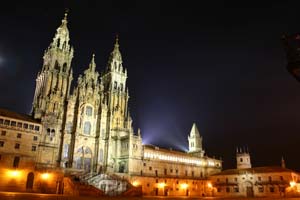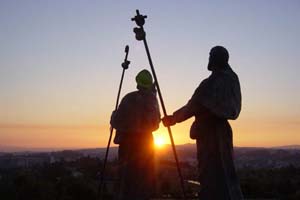Way of St. James
St. James (or Santiago, in Spanish) is considered to be the patron saint not only of Spain, but also of Galicia –and of many other cities in the world-. St. James was one of the twelve Apostles, and the first martyr of the then newly created Catholic church. The tradition has it that he was sent to preach and evangelize in Spain. What happened in these travels is the origin of what we know today as the Way of St. James, a world famous pilgrimage route.

During his trips he is supposed to have stopped at Saragossa, where, after being visited by the Virgin Mary, raised a temple on her honor –what we know today as the Basilica del Pilar-. After this, he would have returned to Jerusalem, as the Virgin told him to do, where he was made prisoner and decapitated. His remains were originally buried nearby Jerusalem, but as the revolts against Christians intensified, he was supposedly taken to Galicia, Spain, where he was reburied.
Later, around the 9th century, a hermit called Payo told a Galician bishop that he had seen some lights over an uninhabited hill. When they arrived there, they found a headless corpse in a tomb, who was automatically believed to be St. James. On that place, the King of Asturias ordered to build a small church to honor the saint, which later transformed into Santiago’s Cathedral, a site that became one of the main pilgrimage destinations in the Middle Ages, after Jerusalem and Rome. After this, and because of the Black Death, many wars in the continent, hunger, and the Protestant Reformation, the Way lost a lot of influence, and was almost forgotten until the XX century. Today, the Way of St. James is a very well known tourist route, both for pilgrims (as penance) and excursionists (for many other reasons) from all overt he world, and has been declared a World Heritage Site. Many people walk its different routes throughout Europe and into Spain every year.
It also happens that the 25th of July is the Day of St. James, patron of Spain, and whenever it falls on a Sunday that year is considered to be a Holy Year.  This is one of the reasons why the Way has attracted more and more attention in the past 30 years, having had four different Holy Years since 1985. There’s a special document, called the Credencial, but better known as the pilgrim’s passport, that can be acquired at many places along the way, and which is stamped at the hostels it grants access to for very cheap (or even for free). If one has walked 100 kilometers, or cycled 200 km –and is able to prove it through the Credencial-, one gets another document called the Compostela. In the Middle Ages, this was a means to indulgence, supposedly reducing to a half the stay of the person’s soul in the purgatory. If the year was a Holy Year, the pilgrim would get plenary indulgence.
This is one of the reasons why the Way has attracted more and more attention in the past 30 years, having had four different Holy Years since 1985. There’s a special document, called the Credencial, but better known as the pilgrim’s passport, that can be acquired at many places along the way, and which is stamped at the hostels it grants access to for very cheap (or even for free). If one has walked 100 kilometers, or cycled 200 km –and is able to prove it through the Credencial-, one gets another document called the Compostela. In the Middle Ages, this was a means to indulgence, supposedly reducing to a half the stay of the person’s soul in the purgatory. If the year was a Holy Year, the pilgrim would get plenary indulgence.
Every day at noon a mass for the pilgrims takes place at Santiago’s cathedral. The names, places of origin and starting points of the ones that received the Compostela the day before are announced during the service. Another striking element of the celebration is the interplay between the beautiful music of the “Hymn to Santiago” together with the swinging along the side nave of the cathedral of a giant thurible or incensory called the Botafumeiro. Once this is finished, the highest spiritual moment of the celebration takes place, the Communion, after which the group of pilgrims exits joyously the premises of the church.
If you never considered walking the Way of St. James before, and are somehow compelled to take on this life-changing experience, consider spending a summer in Spain to do it, which is also a good opportunity to learn and practice your Spanish skills.

 Who hasn't ever heard abouth the famous Way of St. James ? Many have probably even walked it... In any case, this article will tell you about some of the details around its origin and significance.
Who hasn't ever heard abouth the famous Way of St. James ? Many have probably even walked it... In any case, this article will tell you about some of the details around its origin and significance. 